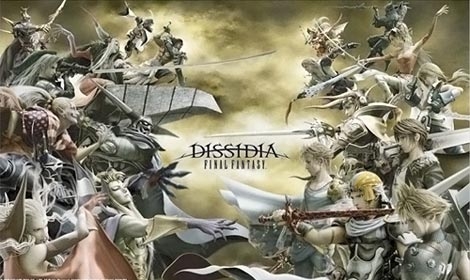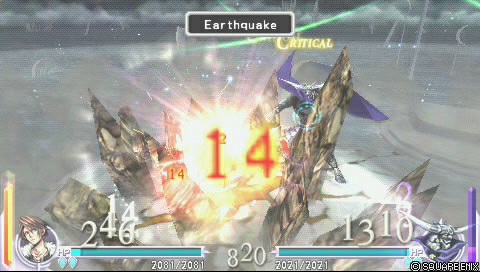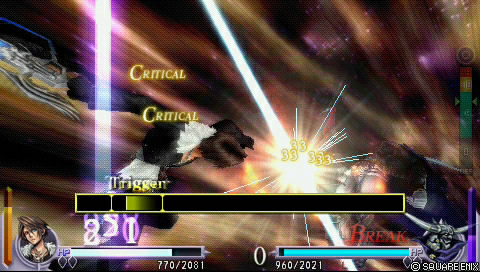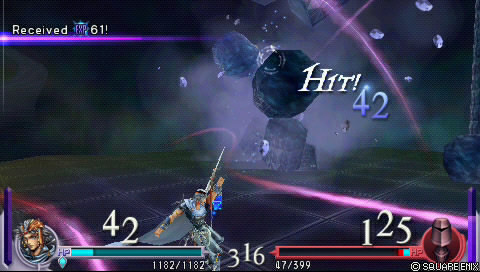Dissidia: Final Fantasy is a new PSP fighting game developed by Square Enix, featuring characters from the original Final Fantasy to Final Fantasy XI. Having developed fighting games in the past like Ehrgeiz and Tobal, Square Enix is no newcomer to fighting games, but how well would it fare after such a long hiatus?
Presentation
As expected of Square Enix, this game looks beautiful. There's not much to say about the character models; however, the stages are incredible. Each stage is a recreation of different locales from the Final Fantasy universe, giving players a flood of nostalgia. If you haven't played some of the games, which is a big possibility for any of the Final Fantasies from I through VI, the stages still look fantastic; beautiful structures like Kefka's Tower or the spiraling stairs in Ultimecia's Castle are amazing in their own right and do not require any past Final Fantasy experience to appreciate.
The music is also something that fans of Final Fantasy will appreciate. Featuring nostalgic battle tracks from every featured game, the music is not only fan service, but is quite fitting for the engaging battles as well. The only gripe is that certain tracks are missing; “Liberi Fatali” from Final Fantasy VIII would have been a no-brainer, yet it is nowhere to be found. In its place, we get “Blue Fields,” “Don't be Afraid” and “The Extreme” - none of which are as iconic. Aside from some striking omissions, the music is spot on, especially with some arrangements breathing new life into memorable tracks.
Taking only two characters from each Final Fantasy game, Dissidia leaves much to be desired. Although most of the main characters like Cloud, Terra, and Tidus are present, their supporting cast are blatanly missing. Since Dissidia is a PSP game, it has its limits, which explains the smaller character roster. It would have been interesting, however, to see characters like Balthier or Sabin in the mix. But it seems the series will have to develop more before minor characters are given some love.
Gameplay
Taking a new approach to making fighting games, Dissidia has several striking features that easily differentiates it from the rest. The most easily noticeable difference is the camera - instead of being a side view like most fighting games, whether it be 2D or 3D, the camera follows the player from behind like a typical action game. It works for the PSP, considering that it's a portable system with a smaller screen. This perspective makes the screen feel less claustrophobic, despite it being so small.
The other difference is the process of damaging the opponent. Rather than the standard formula where each hit takes off certain amount of health in traditional fighting games, Dissidia introduces two types of attacks: HP attacks and Bravery attacks. Likewise, players have two things to keep track of: their HP and Bravery. HP, or hit points, should be pretty self explanatory for anybody who has ever touched an RPG - it's the health your character has left. Bravery, on the other hand, is a new element made for Dissidia. It represents the player's attack. The amount of Bravery the player has at any point is the amount of HP damage that player will inflict. Once it hits zero, the character's Bravery will break, which also gives the opposing player a big chunk of Bravery as a reward. While the character's bravery is broken, the player can do nothing until it recovers fully. Once the player does an HP attack, the character's Bravery will reset to zero, which makes a Bravery break imminent. Eventually, the Bravery will recover fully. This system makes sure that players can't continually do HP attacks to just whittle away at an opponent's health, but must strategically make use of both Bravery and HP attacks.
Players will also have access to an EX mode. Once a bar beside the character's health is filled, players can activate EX mode by holding R and pressing Square, which puts the character in EX mode. In this mode, characters will have a set of abilities they normally don't have, such as health regeneration or special attacks. The most notable ability is an EX burst, which activates after hitting an HP attack. Best described as Dissidia's equivalent of a limit break, EX Burst attacks will prompt players to do something, such as pressing button combinations or simply mashing on something as fast as possible. While the former may be fun, the latter gets old quickly and seems like a lazy attempt on Square Enix's part to add "interactivity" to EX Burst attacks. On the other hand, some characters have truly notable EX Burst attacks. Squall's, for example, commands the player to press R in rhythm with his slashes, much like his limit break.
Dissidia also features interactive stages - walls are scalable and pillars are destructible. This level of interactivity changes the game with each level, much like other fighting games that stray from the traditional formula like the Super Smash Brothers series. When cornered, instead of forcing a way out by jumping over the opponent, players can simply run away on the wall. Or if opponents are hiding behind a pillar, you can destroy it to hunt them down. These stage should never be a bland backdrop where the fighting takes place, and Dissidia made sure it was part of the players' experience.
Being a Square Enix game, Dissidia wouldn't be complete without its fair share of RPG elements. Players can customize characters through all of the standard RPG options, such as their weapons, abilities, and summons. In addition to customization options, players will also have to manage their characters' levels; just like an RPG, enemies with higher levels will be harder to defeat, so players will have to grind when the going gets too tough. For RPG lovers, it will be a treat to see such familiar aspects in a new game. For fighting game enthusiasts, these elements will be an annoyance. The time wasted in grinding a character could easily be spent playing actual players instead. The customization options never affect the characters' aesthetics, which makes it seem like a gimmick the developers used to attract RPG fans.
At times, while providing the dramatic angles that make Dissidia so spectacular to watch, it also leads to gameplay problems. Following directly behind the player, the camera will lead the player into corners between walls and platforms at times with no means of escape other than to jump away, which leaves a bitter aftertaste of an otherwise exciting battle. This is notorious in levels with multiple stories, such as Ultimecia's Castle.
Story
It is odd to find that Square Enix, who often produces games with epic stories , can make such a weak story. Using only two characters from each Final Fantasy, the character interactions from previous Final Fantasy games are nowhere to be found. At best, this can be described as a generic crossover story, and at worst, a badly written fan fiction. For the most part, characters from Final Fantasy games aren't defined by their personality, but by their journeys and stories. With the exception of Tidus, who can either be described as colorful or annoying depending on your tastes, the rest of the cast don't have much going for them. The monotone voices combined with dialogue that is trying way too hard to be symbolic practically begs you to skip the cutscenes.
Conclusion
Dissidia is a fresh new game with some interesting gameplay designs for the fighting game genre. Being the first, and quite experimental fighting game Square Enix has developed in so long, Dissidia has its fair share of flaws in the camera , roster, and story. While these flaws might stand out at times, Dissidia is still a fun experience for the PSP. Hopefully, we will see future iterations of Dissidia fix these problems and build a legitimate franchise around this fresh, new formula for the fighting game genre.





